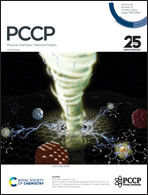Design of high performance nitrogen reduction electrocatalysts by doping defective polyoxometalate with a single atom promoter†
Abstract
Single-atom catalysts (SACs) are emerging as promising candidates for electrochemical nitrogen reduction reaction (NRR). Previous studies have shown that the single-atom centers of SACs can not only serve as active sites, but also act as promoters to affect the catalytic properties. However, the use of single metal atoms as promoters in electrocatalysis has rarely been studied. In this work, the defective Keggin-type phosphomolybdic acid (PMA) is used as a substrate to support the single metal atoms. We aim to tune the electronic structures of the exposed molybdenum active sites on defective PMA by using these supported single atoms as promoters for efficient NRR. Firstly, the stability and N2 adsorption capacity were studied to screen for an effective catalyst capable of activating N2. Most of the SACs were found to have good stability and N2 adsorption capacity. Then, we compared the selectivity and NRR activity of the catalysts and found that catalysts with metal atom promoters have improved NRR selectivity and activity. Finally, electronic structure analysis was carried out to understand the promoting effect of the promoter on N2 activation and the activity of the NRR process. This work provides a new strategy for designing efficient catalysts for electrocatalytic reactions by introducing promoters.



 Please wait while we load your content...
Please wait while we load your content...